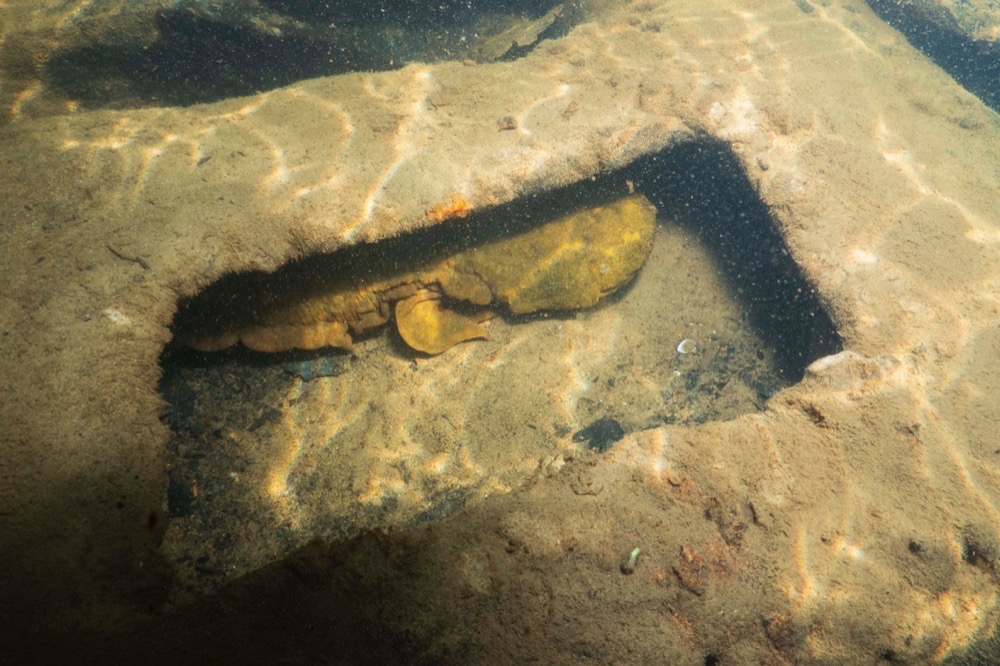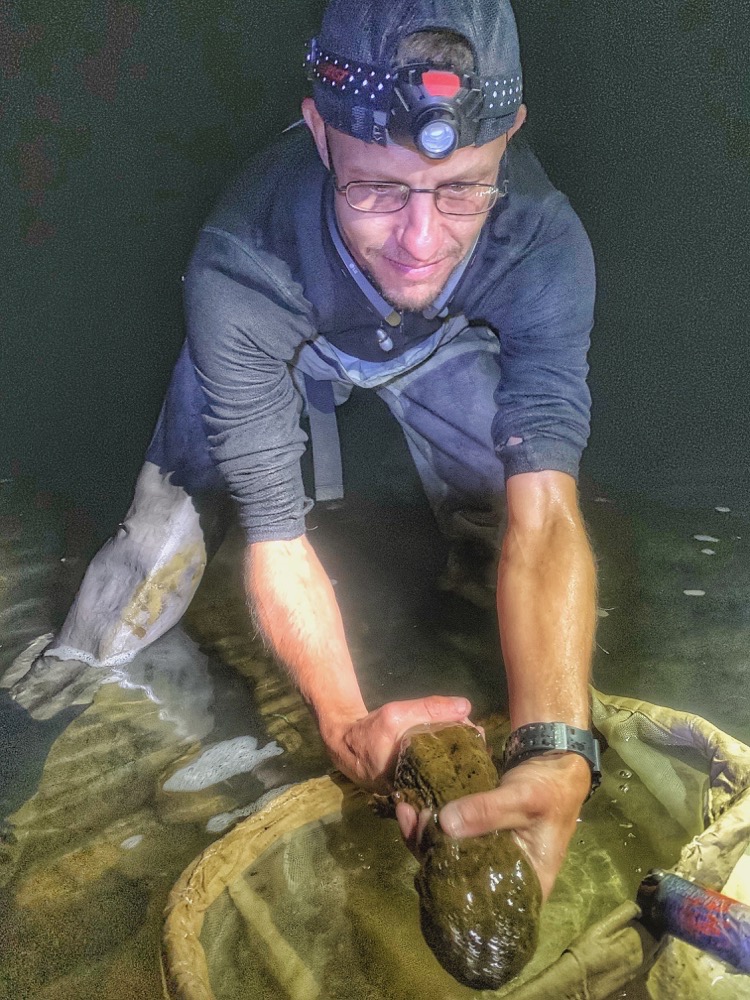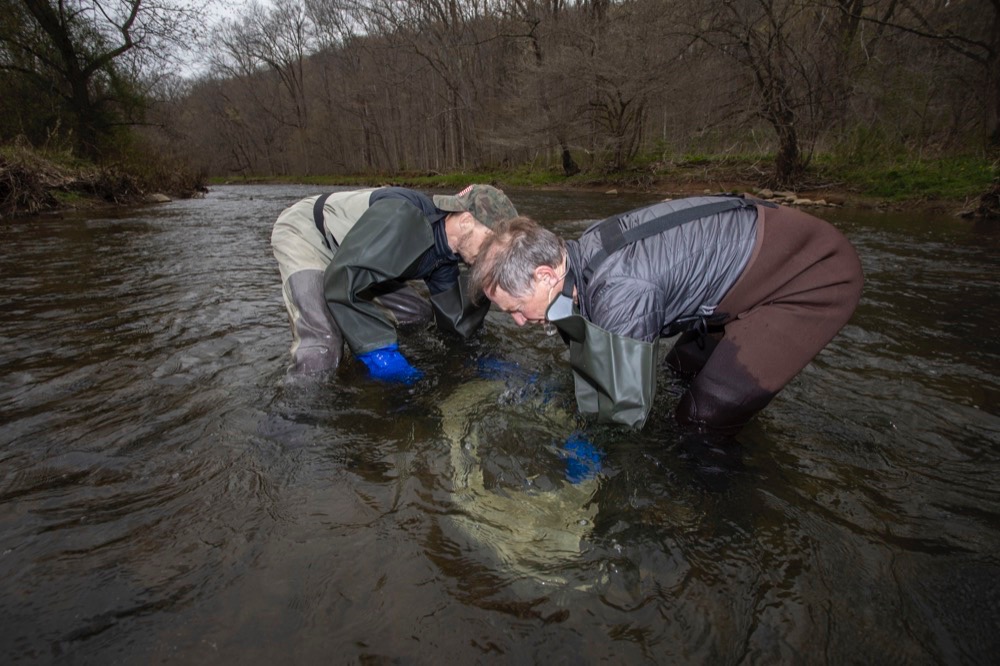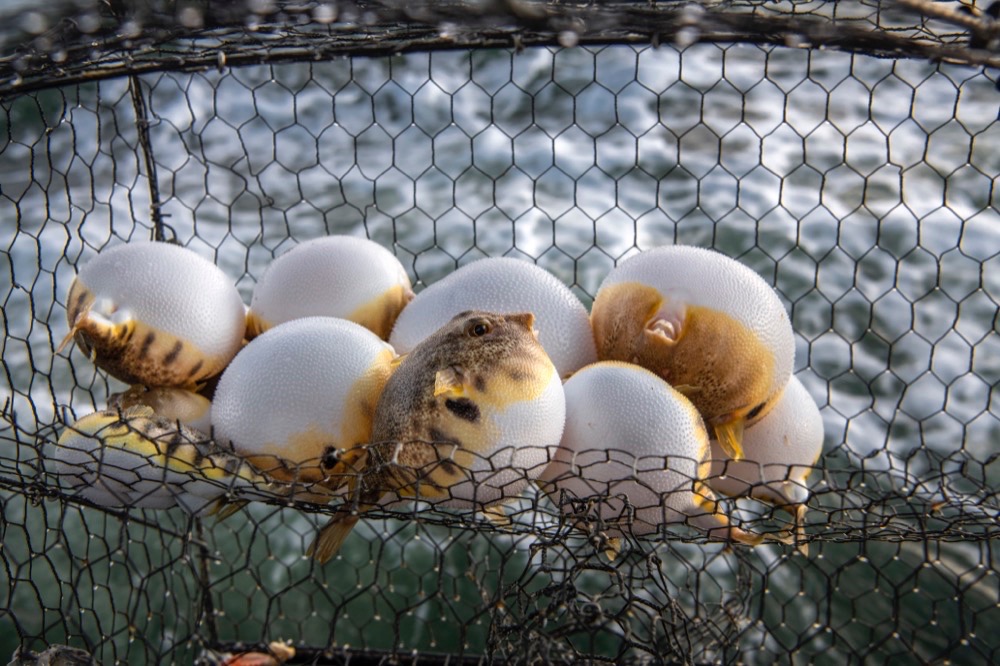Searching for salamanders in Maryland’s mountain streams
Ed Thompson is passionate about hellbenders. The retired biologist, who has the rough exterior of a mountain man and a heart of gold, has been fascinated with the odd-looking creatures for decades, and his enthusiasm for these animals is contagious. Reminiscing about one of his most memorable moments with the species, he says with a chuckle, “Once, while making a show for MPT, I decided to taste hellbender slime. Boy, was it bitter!” It was a memorable, if unconventional, way to show how the species are believed to defend themselves from potential predators.
Many are surprised to learn that Maryland is home to North America’s largest salamander. The Eastern hellbender is one of the most unique animals to inhabit North America, let alone the state. Reaching average lengths of 12–15 inches, the only salamanders that are larger are the critically endangered Chinese and Japanese giant salamanders. Unlike other salamanders, the hellbender lives its life completely underwater in cool, rocky, fast-flowing mountain streams. They breathe through wrinkly flaps of skin on the sides of their bodies, though they also have vestigial lungs. Their bizarre, Frankenstein-like appearance has plagued the hellbender with an array of nicknames: snot otter, Allegheny alligator, mud devil, grampus, and even “lasagna lizard.” Mostly nocturnal, the solitary hellbender hides under rocks during the day and emerges at night to hunt crayfish.

They are also an indicator species, which means if the pollutant-sensitive hellbender resides in a particular location, the water quality of that river is usually good. Historically, the hellbender was found in Maryland’s Susquehanna drainage, though today it is only found in the farthest-west portion of
Garrett County.
Thompson, who spent 30 years working for the Maryland Department of Natural Resources Wildlife and Heritage Service, has seen their declining numbers firsthand. “There is a very clear trend that the population is declining. Without population augmentation, the (Maryland) hellbenders are on their way out, unfortunately,” he warns.
It hasn’t been easy for the hellbender. For decades, the population has continued to decline throughout its range from the Appalachians of southern New York to northern Georgia, as well as parts of the Midwest. Their conservation status is listed as near threatened by the International Union for Conservation in Nature (IUCN), and the small population in Maryland is listed as endangered. The species is currently not listed as endangered under the Endangered Species Act, though a subspecies found only in the Ozark
Plateau of Missouri and Arkansas (the Ozark hellbender) is.
“The biggest issue for hellbenders in Maryland is the population falling below a threshold where they cannot replace themselves,” says Thompson. In other states, such as New York and Ohio, hellbenders reared in captivity have been released back into the wild to boost the population. “This is mainly because humans have treated our streams and rivers with total disrespect ever since we got to this country. Silt and sedimentation is probably the worst offender, but poisoning the water with acid mine drainage and other chemical pollution is obviously a factor as well.”
In Maryland’s little remaining hellbender habitat, sedimentation is a significant issue and its consequences are far reaching. Sediment input from multiple sources such as agriculture, deforestation, road construction, and development has negatively impacted many streams in the state. This in turn negatively affects many freshwater species, from insects to fish, because the excess sediments fill spaces in the substrate that provide habitat for eggs and early life stages. For hellbenders, the sediment reduces the fills in the undersides of the rocks that hellbenders breed under, resulting in breeding failure in many populations.
Poor water quality, resulting from the damming of rivers, acid mine drainage, sewage, fertilizers and herbicides, and even road de-icing salts, impact these animals at any time, but especially in the early life stages of eggs, larvae, and juveniles. Like all amphibians, hellbenders have permeable skin, making them especially sensitive to environmental pollutants. Thompson last found a six-inch juvenile in 1986 and a sub adult in the mid-1990s and has only encountered adults since, a troubling sign.

Despite the seemingly dire state of things, there is still hope for this odd but lovable animal. In 2014 Thompson began placing hellbender nesting boxes to aid in reproduction. You’re probably wondering what a hellbender nesting box is; it’s not something that comes up in everyday conversation. Imagine a large, boot-shaped, concrete box weighing over 50 pounds that essentially provides a sediment-free shelter and nesting area for hellbenders. The hellbender enters the nest through the neck of the boot where it can breed and protect its eggs. (Another cool hellbender fact: It is the male that stands guard over the eggs.)
The technique was first used in 2012 when scientists placed the boxes in hellbender streams in Missouri, resulting in some early successes. It is now being used almost everywhere with a hellbender population. In 2020 the Maryland Natural Heritage program awarded Frostburg State University a grant to create and place 50 new boxes to help with the state’s small population, under principal investigator Dan Hocking, who was assisted by his student Kodi Bowers.
For Bowers, an Iraq war veteran and Purple Heart recipient, the connection to the species is personal. “Hellbenders and the natural world have helped fill a void in my life after the United States Marine Corps. Being involved in projects like this help to quiet the mind and focus on the task at hand. It gives a sense of purpose and a greater sense of accomplishment, knowing that you are helping to impact and change the future of a species for the better,” he says.
Shortly after the project began, Hocking left FSU and Dr. Richard Raesly took over the project. In the almost decade since the original boxes were placed in a Missouri stream, some much-needed upgrades have been implemented. “While the [original] design was successful, there were problems with the accumulation of sediment and boxes being washed away at high flows. More recently, a more hydrodynamic design was developed by researchers at the University of Missouri,” says Raesly.
I went out with Raesly and Bowers early in the summer to see how the boxes work. With a rock climber’s form and youthful enthusiasm for all things ecological and aquatic, Raesly lifted the heavy slab of concrete on his back and carried it with Bowers to a site for a first test run using the boxes in the field. Wading through the fast-flowing water, he located a good spot. After placing the box into the frigid water, they searched for rocks to help weigh it down and blend into the stream floor.
“The nest boxes that are being deployed will help to census the population. Historically, determination of population status required flipping over large rocks that could disturb the hellbenders,” says Raesly. Because the species is so sensitive and the population so low, the risk of disturbance to the species has always been a touchy topic, but technology could make the survey efforts much less intrusive. “The new boxes have lids that can be opened without disturbing a nesting hellbender, and half the boxes have a small port that can be opened to insert a fiber-optic camera to determine if the box is occupied, “ he says.

Hellbenders breed in late summer. After mating, the male will protect the eggs and juveniles for upwards of seven months. Because the boxes are designed to prevent sediment from entering the box, this also protects eggs and any juveniles from being smothered. As the autumn approaches, a census of the population will be taken by checking whether any of the boxes are occupied. In recent years, less than a handful of hellbenders have been documented using the boxes. This is partly due to the fact that they are difficult to study and will leave a box if sediment accrues.
Reflecting on a previous survey, Bowers reminisces, “We sampled maybe half a dozen boxes one night and I wasn’t very optimistic, considering how rare the species truly is in the state. We eventually came upon a box and opened the lid and there was one inside. It was probably one of the most exciting times of my life—not only to find one, but also to hold one.”
Even for researchers, finding a hellbender is quite an event. With such a small population it is remarkable to encounter one in a nesting box. On a late summer’s day, I accompanied Ed Thompson to check the boxes. The water levels were low, perfect for the survey, and as we walked into the river he warned me not to get my hopes up. After a full day in the river, we were elated to find two nesting boxes that had hellbenders inside, though we saw no eggs.
Observing that first wild hellbender was an incredible moment. It moved through the box swiftly. The first thing I noticed was the size, something that is not lost on Bowers. “You really cannot comprehend how big one is by looking at a picture,” he says. “It isn’t until you see one in person and hold it in your hands that you truly take in the significance of the experience.” They also disappear quickly and easily, and their mysterious nature makes them difficult to study, even in the few areas that still host healthy numbers.
As ancient as hellbenders are, there is still much to be discovered. Once a creature of Appalachian lore, it is now seen as one of the many “canaries in the coal mine”—animals whose presence alone can speak to the health of an ecosystem. But what was once only myth is now propped up with conservation science. Are the efforts of individuals like Ed Thompson, Richard Raesly, Kodi Bowers, and others enough to keep them alive in Maryland? I sure hope so.




